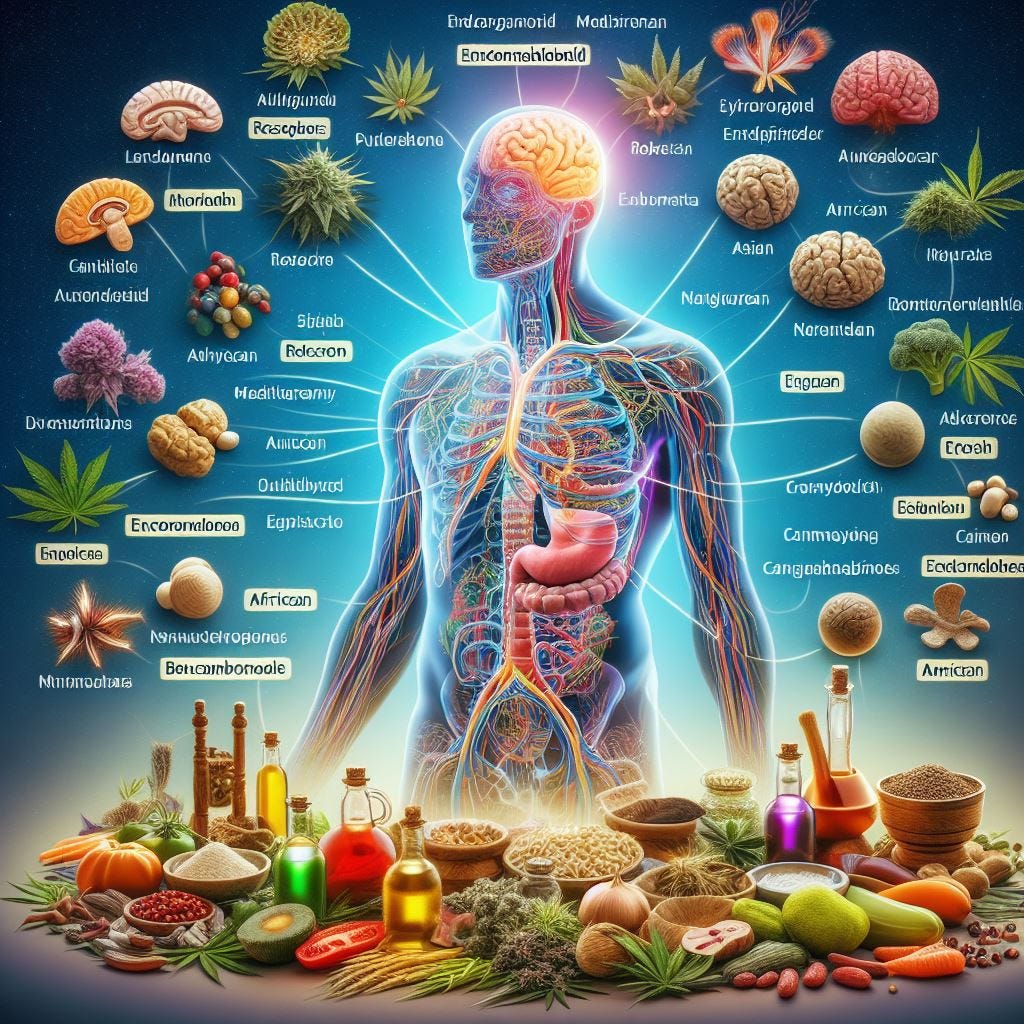Alchemical Wizard 39 : The Endocannabinoid System & Ancestral Diets!
Let us discuss how the ECS works and how optimizing it can support our physical and mental health as we get further into the Ascension Process!
Also known as the "master regulatory system," the Endocannabinoid System is a cellular level communication network responsible for maintaining homeostasis across all our biological body's organs and physiological functions.
Homeostasis is the concept that most biological systems are actively regulated to maintain conditions within a narrow range. Our bodies don’t want temperatures to be too hot or too cold, blood sugar levels too high or too low, etc. Conditions need to be just right for our cells to maintain optimum performance. Because of its crucial role in homeostasis, the ECS is widespread throughout the animal kingdom. Its key pieces evolved millions of years ago and the ECS can be found in all vertebrate species.
Some key components of the endocannabinoid system are, Cannabinoid receptors found on the surface of cells, which sense the presence of endocannabinoids and endocannabinoid, the small molecules that activate cannabinoid receptors and the metabolic enzymes that quickly break down endocannabinoids after they are used.
Endocannabinoids bind with endocannabinoid receptors, which reside on the surface of a variety of types of cells throughout the body, to trigger a physiological response. Researchers have focused on two endocannabinoid receptors in particular. Cannabinoid 1 (CB1) Receptors of which most of these are in the central nervous system, especially neurons (nerve cells) in the brain. Both anandamide and THC (the compound in cannabis that makes people feel high) bind with CD1 receptors. And Cannabinoid 2 (CB2) Receptors that are located mainly on immune cells but are also found in the central nervous system. The endocannabinoid 2-AG binds with CB2 receptors. CB2 receptors are a major reason why cannabinoids, including THC and CBD, often have anti-inflammatory effects!
Enzymes are responsible for both producing endocannabinoids and breaking them down when they are no longer needed. There are two major enzymes that break down endocannabinoids. Fatty acid amide hydrolase (FAAH), which breaks down anandamide and Monoacylglycerol (MAG-L), which breaks down 2-AG.
While scientists initially believed that the ECS only affected the brain and nerves, they now agree that it exerts an influence on almost every part of the body. Skin, bone, fat tissue, kidneys, liver, pancreas, skeletal muscle, heart, blood vessels, the gastrointestinal tract, and perhaps our entire Endocrine System!
Researchers are continuing to investigate the many complex ways in which the ECS interacts with the central nervous system, the peripheral nervous system, the immune system, the digestive system, the reproductive system, virtually all the major organs, and many other parts of our biological body. Since their discovery, endocannabinoids have been found to play a role in Thermoregulation, Memory and Mood, Appetite, Stress and Sleep, Metabolism, Immune function, Reproduction and Pain sensation!
Brain cells (neurons) communicate by sending electrochemical signals to one another. Each neuron must listen to its partners to decide whether it will fire off its own signal at any given moment. However, neurons don’t like to get too much input. There is a balancing zone. If they get overloaded by signals, it can be toxic. That’s where endocannabinoids come in! One of the two outputting neurons might become overactive and send too many signals to the neuron that’s listening. When that happens, the neuron that’s listening will produce endocannabinoids specifically where it’s connected to the overactive neuron. Those endocannabinoids will travel back to the “loud” neuron where they bind to CB1 receptors, transmitting a signal that instructs it to quiet down. This brings things back to balance, maintaining homeostasis.
Endocannabinoids travel backward, which is why they’re known as retrograde signals. Most of the time, information flow between neurons is strictly in one direction, from sender neurons that release neurotransmitter signals to receiver neurons that listen to those signals. Endocannabinoids allow receiver neurons to regulate how much input they’re getting, and they do this by sending retrograde signals (endocannabinoids) back to overactive sender neurons. But the brain isn’t the only organ that needs to maintain homeostasis. Every other system of the body needs this kind of regulation to help ensure survival, including many aspects of our digestive system and metabolism!
Even though the CB1 receptor is found in highest abundance within the brain, it is also found throughout the body. This includes organs important for energy homeostasis, such as the gastrointestinal tract, pancreas, muscle, and fat cells. And within the nervous system, CB1 receptors are often concentrated in brain areas critical for regulating energy expenditure and metabolism, as well as sensory organs important for finding food (e.g. the nose and tongue).
Most cannabis consumers will tell you that THC promotes hunger and enhances the taste and smell of food. This common experiential report is consistent with what is generally observed in studies. For example, activating CB1 receptors in “taste cells” or “smell cells” in animals tends to increase the perception and attractiveness of odors and foods.
Drugs that activate CB1 receptors (including THC) stimulate hunger and food consumption. For example, THC doesn’t just stimulate feeding in rodents, but alters the types of foods they prefer depending on whether they are already hungry or satiated. Hungry rats given THC show an increased preference for high-fat food compared to high-carbohydrate food, while satiated rats given THC show the opposite trend. Thus, THC can influence what types of food you most want to eat based on your body’s current metabolic state.
The distribution of CB1 receptors across all of these tissues suggests that the ECS has an important role to play in regulating metabolism broadly. That, together with many observations related to how the ECS affects food seeking behavior, has led some scientists to suggest that a major reason the ECS evolved in animals may be to coordinate behavior, metabolism, and sensory perception for the purposes of long-term energy storage and survival. This is where our Ancestral Diets come into play!
We used to eat a lot more wild foods, meaning foraged foods back in the day. Some of these foods had cannabinoid compounds like that of the Hemp plant that has 100’s of cannabinoids! CBD’s, CBN’s, CBG’s, CBDA’s, CBC’s, etc. And most of these Ancestral Diets had the supportive epigenetical nutrition in helping the ECS System regulate Homeostasis!
An Ancestral diet centers around eating unrefined, unprocessed, whole foods just like our primal ancestors. An Ancestral diet is an umbrella term that describes ways of eating that are based on unprocessed, organic, natural, and wholesome foods that you can harvest from the oceans, rivers, lakes, and earth by fishing, gathering, and hunting.
Compared to our primal ancestors, our genome hasn’t changed a lot. Thus, genetically, modern humans are adapted to the same diet and foods our ancestors ate. Which would be better for us as we have turned to processed foods in these modern times.
There are many advantages to an Ancestral diet, from weight loss to decreased inflammation, reversal of metabolic syndrome, and for sure, a better gut microbiome! Diets include organic, unprocessed, natural, and wholesome foods such as fruits, vegetables, meats, nuts, and seeds. We really should try to avoid all heavily processed, industrial foods. If at all possible, from the ground, off the vine and off the tree! Heirloom and Foraged foods go beyond the “organic” diets of modern times! Just a consideration to think about when weighing the many options of Ancestral Dieting!
Blessings Everyone as we continue with Holistic Health modalities to inspire confidence as we unlock resources to make this Ascension shift more meliorative! We are Sovereign and We are most defiantly Freeing Ourselves! And Please Stay Hydrated as the SEP’S (Solar Energetic Particles) and Air Showers continue until this adaptation to a higher frequency is completed!
Travis Carper - Ascension Health Coach / Alternative & Holistic Health Service https://www.facebook.com/traviscarper888/ | https://www.linkedin.com/in/traviscarper888/
Additional References :
The Endocannabinoid System: What It Is & How To Support It - https://www.mindbodygreen.com/articles/the-endocannabinoid-system-how-it-works-and-what-it-does
The Ultimate Guide to Understanding the Endocannabinoid System - https://leafydoc.com/endocannabinoid-system-explained
Introduction to the Endocannabinoid System - https://ethanrusso.org/wp-content/uploads/2020/02/Russo-Introduction-to-the-Endocannabinoid-System-Revised-January-2020.pdf
Care and Feeding of the Endocannabinoid System: A Systematic Review - https://journals.plos.org/plosone/article?id=10.1371/journal.pone.0089566
The Endocannabinoid System: Essential and mysterious - https://www.health.harvard.edu/blog/the-endocannabinoid-system-essential-and-mysterious-202108112569
What Is the Endocannabinoid System? - https://www.verywellhealth.com/what-is-the-endocannabinoid-system-4171855
Key Differences Between CBD, CBDA, CBN, CBG, CBC, and CBDV - https://intrinsichemp.com/cbd-cbda-cbn-cbg-cbc-cbdv-differences/
Ancestral Diets: How to Eat Like Your Ancestors and Why - https://www.prohealth.com/blogs/control-how-you-age/ancestral-diets-how-to-eat-like-your-ancestors-and-why
The Ancestral Diet: How to Plan a Diet Based on Your Ancestry - https://www.smgf.org/ancestral-diet
What Are the Health Benefits of an Ancestral Diet? - https://wellnesswithkaelyn.com/blog/health-benefits-of-an-ancestral-diet
The Ancestral Kitchen Podcast - https://ancestralkitchenpodcast.com/category/podcast/
Affiliated & Where I Shop Myself :
Mountain Rose Herbs “ Mountain Rose Herbs offers free educational resources to the community.” - https://get.aspr.app/SHpH5
Returning to our Ancestral Diets with Jenny Powers -






